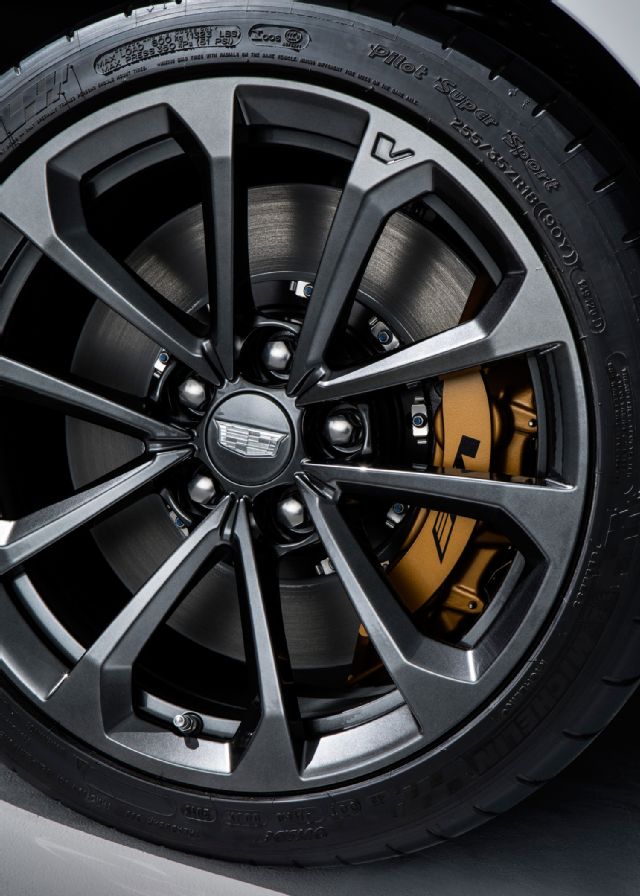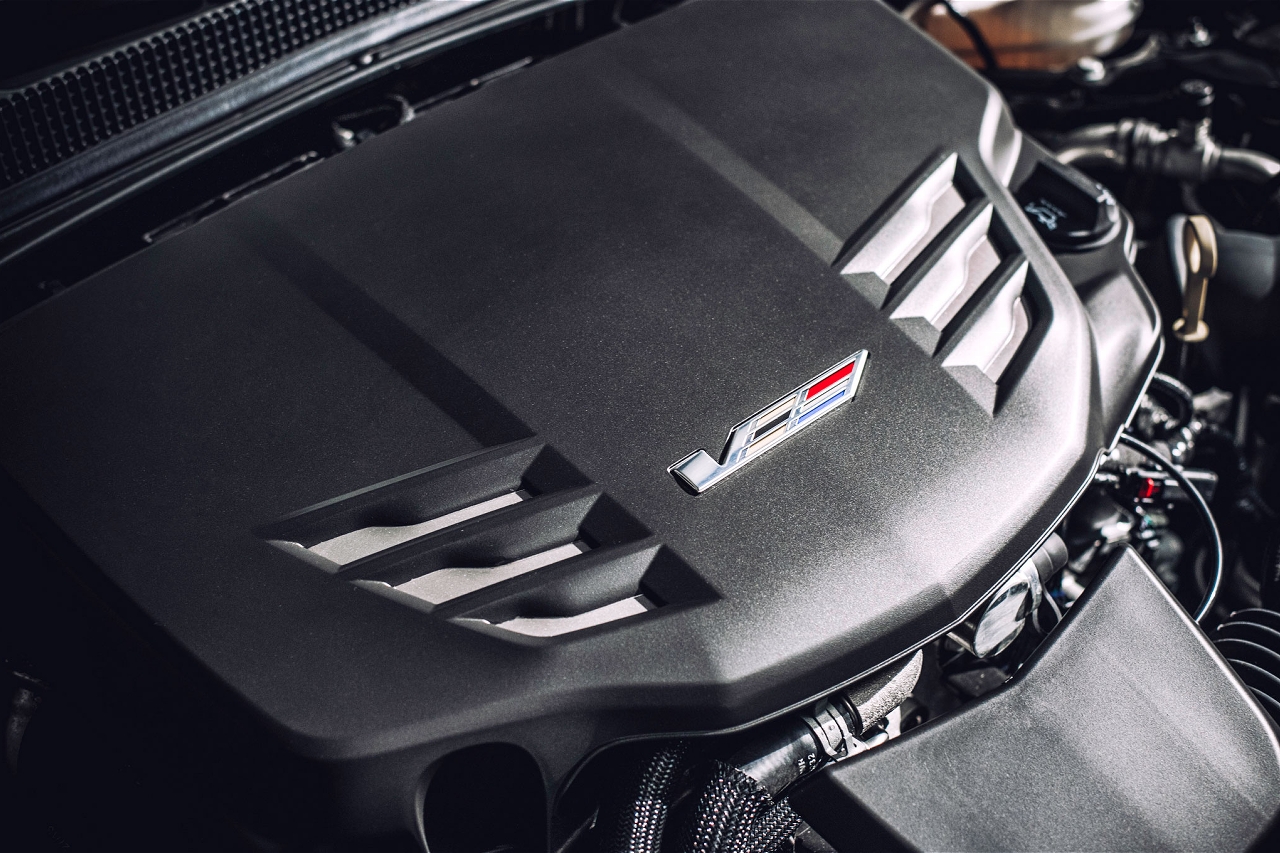The Tech side of the 2016 Cadillac ATS-V
by Hib Halverson
November 26, 2014
Imagery by GM Communications.
It's freakin' amazing that General Motors is going to come to market with a car like the ATS-V. We expect Corvettes to do 0-60 in three-nine, do the quarter in the 12s and top out at 185+. But–an American small coupe or sedan which can do that? A Cadillac which can match a 2015 BMW M3 from 0-60 and has a higher top speed? Now that's freakin' amazing!
The ATS-V won't go on sale until late in 2015, so at this writing, at the end of November 2014, no one but a few GM development engineers have driven one, but just prior to the L.A. Auto Show, Cadillac released a lot of technical details about the car. The Cadillac V-Net Staff reviewed all that data, directed some follow-up questions to media contacts at Cadillac and GM Powertrain, then compiled this technical briefing. Let's start with the car's chassis.
The ATS, built on GM's "Alpha" platform, has pretty good structure already, but, when Cadillac puts the fabled "-V" on the decklid then tells us the car will, "...have impressive track capability" you know the engineers who do V-Series ride-and-handing had to make some changes. An ATS-V's underbody structure has reinforcements, such as an aluminum shear panel at the front of the chassis, a strut tower brace, engine compartment braces and strengthening of certain parts of the rear underbody, which make the car 25% stiffer. Improvements in chassis parts were required, too. The smallest -V gets a 50% increase in front roll stiffness via higher rate springs and stabilizer bar. Front suspension compliance is reduced by replacement of traditional suspension bushings with "zero-compliance, cross-axis ball joints" and more rigid suspension links. The ATS-V uses a ZF variable-ratio, electric power steering gear which is calibrated for increased effort to give the driver improved steering feel.
In the rear, the ATS' five-link suspension has be upgraded for V-duty with higher rate springs and stabilizer bar. It's, also, been revised for decreased roll center migration and improved anti-squat geometry. Some components, such as bushings and suspension cradle mounts were stiffened. A stronger driveshaft and and axle shafts with increased "asymmetry" (driver-side shaft is stiffer than the passenger-side unit) damps power hop during maximum acceleration. Lastly, but certainly not least, all ATS-V drive axles are equipped with an electronically-controlled, hydraulically-operated, limited-slip differential, or "eLSD". A computer-controlled, hydraulic clutch allows the differential to have any mechanical connection between the two rear tires, from no connection ("all slip", or an "open diff") to fully-locked (no slip), that the eLSD control module deems necessary for maximum handling performance. We could write an entire article about the vehicle dynamics advantages of the eLSD but, for now, suffice to say it's an amazing advancement in chassis technology which will help make an ATS-V easier and more fun to drive though the twisties of your favorite back road and will make the car bad fast on a road course.
 Magnetic Ride Control (some call it "magnaride" or just "MR") will, also, be standard on the ATS-V. GM's "third-generation" MR senses the road surface a thousand times per second, sending data to the magnaride control module. MR shock absorbers are filled with "magneto-rheological fluid" which flows through electromagnets inside the shock which are energized by the MR controller. The strength of the magnetic field varies the fluid's flow characteristics and that changes the shock's damping characteristics in near real time. MR can independently control all four dampers. Improvements in the third generation of the system enable MR to have 40-percent faster damping response. At 60 mph, "3G Magnaride" calculates the optimal damping force for every inch the car travels.
Magnetic Ride Control (some call it "magnaride" or just "MR") will, also, be standard on the ATS-V. GM's "third-generation" MR senses the road surface a thousand times per second, sending data to the magnaride control module. MR shock absorbers are filled with "magneto-rheological fluid" which flows through electromagnets inside the shock which are energized by the MR controller. The strength of the magnetic field varies the fluid's flow characteristics and that changes the shock's damping characteristics in near real time. MR can independently control all four dampers. Improvements in the third generation of the system enable MR to have 40-percent faster damping response. At 60 mph, "3G Magnaride" calculates the optimal damping force for every inch the car travels.
The car's anti-lock brakes use Brembo six-piston calipers on massive 14.5-inch rotors in the front and four-piston calipers on 13.3-in. rotors in the rear. The ATS-V's Performance Traction Management (PTM) system combines control of the eLSD, MR and the Brembo brakes and has five driver-selectable settings for stability-enhancement, traction control and antilock braking, including the segment's only competition-level setting.
The tires on an ATS-V are Michelin Pilot Super Sports, 255/35ZR18s in the front and 275/35ZR18s in the rear. They are not Michelin's "ZP" run-flat tires because Cadillac's engineers decided the stiff, less-compliant tire casings required by run-flats were a compromise to the car's track capability they didn't want to make. In the event of a flat tire, a "tire inflation kit", which comes in the trunk of all ATS-Vs, except those equipped with the optional "Track" package, is deployed to temporarily repair the tire. Wheels are forged aluminum, 18x9s in the front and 18x9.5s in the rear. The wheels are said by GM to be a lower-mass design aimed at reducing unsprung weight. Ok. That's the ride-and-handing story.
Now let's look at what makes the fun happen when you bury the gas pedal. The engine in this bad-assed little Caddy is a ulta-high-performance version of GM's venerable, dual-overhead-camshaft, 3.6-liter, 60° V6. Not only does it have a pair of turbochargers, variable valve timing, direct injection and other performance features as does the LF3, the XTS' full-sized sedan version of the so called "high-feature V6", but parts of the engine package have been further performance-enhanced in the ATS-V's new, LF4.

The cylinder block is common to both turbocharged three-sixes and was revised for the 2016 model year to improve crankcase bay-to-bay breathing and reduce oil windage. It has piston oilers aimed at the bottom of the pistons to help cool them. It has connections for oil and coolant drainback lines from the turbos. For Caddy's "pocket-rocket application", GM Powertrain ripped a page out of the Corvette LS7 book and swapped the standard powdered-metal connecting rods for forged titanium rods. Parts made of titanium have less mass and the advantage of that in a con rod is two-fold: 1), less reciprocating mass allows the engine to rev quicker and 2) it reduces the load on the oil film between the rod bearings and the crankshaft journals when the engine is at high rpm. Though all turbo 3.6es have forged steel crankshafts, the lighter rods required a new crank forging with altered counterweights to compliment the Ti rods. The LF3/4 pistons are cast, eutectic aluminum but have a steel insert for the top ring land and a machined top. In direct-injected engines, the piston top can be used to direct fuel spray from the injector. The piston tops in LF3/4s have "centrally-located dishes" for that purpose. Compression ratio is 10.2:1. The engine's oil pan has a revised baffle assembly and oil pickup which ensures consistent oil pressure and flow during the high-g cornering ATS-V drivers will be able to enjoy.
Heads for 3.6L V6tt engines are made using the Rotocast&tm; process which provides the higher material strength needed in a high specific-output engine. The intake port is a unique design which imparts a tumbling motion to air flow as it spills into the combustion chamber through the 38.3-mm intake valve. The motion from this "high-tumble intake port" contributes to more efficient combustion after the fuel is injected and the spark ignites the mixture. The exhaust valve is 30.6-mm and has a sodium-filled, hollow-stem for adequate valve head cooling under high-rpm/high-load duty cycles and it closes on a specific, AR-20 seat needed for durability at power levels these engines are achieving. The heads' integral exhaust manifolds have both upper and lower coolant jackets for better heat rejection in a high-performance, turbocharged application. Because of the high combustion pressure typical of turbo engines, multi-layer-steel head gaskets are used
The turbocharger housings are liquid-cooled. LF4 turbos have titanium-aluminide exhaust turbines which, because of their lower mass, allow the turbo accelerate or "spool-up" more quickly. Titanium-aluminide turbines reduce rotating inertia by 51%, compared to conventional, Inconel turbines. That means less of the exhaust energy, which spins the turbines, is wasted in stored inertial loads. On LF4, the turbos' compressor wheels and their inlet adapters are optimized for best efficiency at the higher engine speeds and power output attainted by ultra-high performance version of the 3.6L V6. The relatively small turbocharger size and their lightweight turbines reduce lag and provide a more immediate feeling of power.
Both the LF3 and LF4 have vacuum-actuated wastegates to better manage the engine's boost and throttle response. The waste gates are independently controlled which balances the compressors' output and achieves more precise boost response. Rich Bartlett, Assistant Chief Engineer (ACE) for the LF3 and LF4 told the Cadillac V-Net, "The wastegates work in conjunction with vacuum-actuated recirculation valves to eliminate turbocharger "co-surge", a condition typical of twin-turbo architecture which can result in flow reversal under certain conditions, such as right after the throttle closes. This turbocharger system integration contributes to the engine's smoother, more consistent feeling of performance."
The turbos blow into a "low-volume" charge air cooler and induction system, "low-volume" meaning the displacement of the induction system is reduced by to shorter pipes between the turbo outlets and the cooler inlet and between the cooler outlet and the engine's centrally-located throttle body. ACE Bartlett tells the Cadillac V-Net that he estimates total pressurized volume of ATS-V's turbocharger system is reduced by more than 60% compared to typical system designs of the past. That lower volume is another contributor to the engine's rapid throttle response. The LF4's turbocharger system can produce up to 18 pounds boost which makes use of at least 91-octane premium fuel required with 93-octane recommended for best performance.
The GM Powertrain folks tell us all this Cadillac engine magic will be worth 455-horses at 5750-rpm and 445-pound/feet torque at 3500 rpm. What will undoubtedly make the LF4–said by Cadillac to be the most powerful V6 in the compact luxury segment–a blast to drive is it can provide 90% of that 445-lb/ft torque between 2400 and 6000-rpm.
Those buying the littlest V-Series will have two transmission choices, the 6L95M, six-speed manual, previously used in the CTS-V, or a specific version of the, new Hydra-matic 8L90, eight-speed automatic.
The manual has the "Active Rev Matching" feature GM introduced on the 2014 Corvette. It can anticipate downshifts and blip the throttle to match engine speed to transmission speed for a quicker and easier change to a lower gear. The six-speed is also part of PTM and, when the system is enabled, the driver can achieve "no-lift" upshifts and wide-open throttle standing starts using "launch control."
The 8L90 automatic has paddle shifters and a lot more. Designed and built by GM, it delivers shift times rivaling those of dual-clutch manuals. For performance driving, the transmission offers manual control via the steering wheel paddles. A new transmission control system delivers shift performance which matches that of the dual-clutch/semi-automatic transmissions but with the smoothness and refinement one gets from a conventional torque-converter-equipped automatic. The transmission controller can execute commands 160 times per second. Wide-open throttle upshifts take place up to eight-hundredths of a second quicker than those of the dual-clutch trans in a Porsche 911. The 8L90's smaller steps between gears, compared to a six-speed auto, keep the engine closer to the sweet spot of the engine's torque curve, making the most of ATS-V's 445-lbs/ft of torque on the highway or on the racetrack. Additional performance-enhancing features are available with PTM, including "Performance Algorithm Shift" and launch control.
But wait–there's more! Check out the ATS-V's exterior design. Almost every body panel on the ATS-V is unique–from fascias and fenders to the hood, rear spoiler and rocker moldings–and designed to compliment the car's performance, especially it's race track capability. "All of the design elements have a purpose," Cadillac Global Design's Andrew Smith, told the Cadillac V-Net. "They contribute to reduction of aerodynamic lift, better cooling, reduced mass or all of the above."

The design elements Smith talked about include: a vented, carbon fiber hood which not only pulls hot air out of the engine compartment, but reduces lift at high speed by directing that air over the top of car rather than it being trapped under the car where it generates front end lift. - Image: GM Media
The design elements Smith talked about include: a vented, carbon fiber hood which not only pulls hot air out of the engine compartment, but reduces lift at high speed by directing that air over the top of car rather than it being trapped under the car where it generates front end lift. The front fascia has larger grille openings and the mesh pattern of the grilles was enlarged. Both these changes to increase air flow to the engine. Under the fascia, a front splitter enhances handling by forcing air to push down on the front of the car rather than flow under it and cause lift. The rocker moldings, rear fascia and rear spoiler are also "aero-optimized." The fenders were widened to accommodate the wider front and rear wheels and the Pilot Super Sports. The wheels and the brake calipers are offered with three finishes, allowing owners to personalize their ATS-V.
"Carbon Fiber" and "Track" packages will be available and will take aero performance and mass optimization to higher levels. The "Carbon Fiber" package includes a more aggressive front splitter, hood vent trim and rear diffuser along with composite rocker extensions and a taller, body-color rear spoiler. The "Track" package includes the components of the Carbon Fiber package, plus the Performance Data Recorder and a lightweight battery. It, also, deletes the standard floor mats and tire inflator kit to save weight.
The design and relationship of key interior components are focused on performance-driving ergonomics. All of the "contact points"–steering wheel, seats, shifter and pedals–are designed to enhance performance driving experiences. Optional 16-way-adjustable Recaro front seats have firm, adjustable side bolsters which hold the driver and front passenger in place during aggressive driving. They have luxury-performance feel, trimmed in Mulan leather with sueded microfiber inserts and seatbacks. The rest of the interior features Cadillac's handcrafted, cut-and-sew elements with decorative stitching and premium materials, including carbon fiber.
The ATS-V also features a unique version of Cadillac's 5.7-inch, three-window instrument panel cluster display, with V-Series graphics and distinctive gauge readouts. It is also equipped with the latest connectivity technologies from Cadillac, including: CUE with Bluetooth connectivity and voice recognition, text-to-voice which converts incoming texts to speech then reads them over through audio system speakers, USB, auxiliary and SD memory card ports and finally, OnStar 4G LTE connectivity with a built-in Wi-Fi hotspot. The optional Performance Data Recorder is controlled via CUE's color touch screen and recordings can be reviewed on the screen when the vehicle is parked.
So there you have it: the technical low-down on Cadillac's ATS-V a track-worthy, BMW-busting, American-made sports-coupe or sports-sedan.
